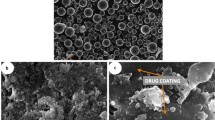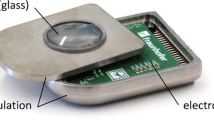A hermetic encapsulation system for implantable telemetric electronic devices has been developed. It is based on the combination of a glass-ceramic material transparent to radio-frequency signals with commercially pure titanium. The materials were joined by active metal brazing, resulting in a multi-layer structure. The in vivo and in vitro behaviour of this metal-ceramic interface was studied. In vivo experiments consisted of subcutaneous implantation of capsules in piglets and pigs with different weights, while the in vitro tests consisted of electrochemical techniques aimed at characterizing the degradation behaviour of the interface. Electrochemical experiments were conducted at 37°C in a simulated physiological solution (Hank's Balanced Salt Solution; HBSS).
Results show that a silver-rich phase was formed at the interface, both in living tissue and in HBSS. Chloride seems to have an important role in the reaction mechanism. The mechanical integrity of the capsules was not affected by this reaction under in vivo conditions.
Similar content being viewed by others
References
M. C. SHULTS, R. K. RHODES, S. J. UPDIKE, B. J. GILLIGAN and W. N. REINING, IEEE Trans. Biomed. Eng BME-41 (1994) 937.
J. W. BORETOS and M. SZYCHER, in “Synthetic Biomedical Polymers: Concepts and Applications” (Techomic Publishing Company, Westport, CT, 1980) p. 187.
J. W. BORETOS, IEEE Trans. Indust. Elec. Control Instrum. IECI-17 (1970) 151.
W. H. KO and T. SPEAR, in “Implantable Sensors for Closedloop Prosthetic Systems”, edited by W. H. Ko (Futura publishing, Mount Kisco, New York, 1985) p. 259.
R. K. TRAEGER, IEEE Trans. Parts Hybrids Packaging PHP-13 (1977) 147.
P. E. K. DONALDSON, IEEE Trans. Biomed. Eng. BME-23 (1976) 281.
M. P. LOUGHLAN and S. J. ALCOCK, Meeting Report: Chemical sensors for in vivo monitoring: Packaging, biocompatibility, stability, Biosens. Bioelectron. 6 (1991) 87.
L. BOWMAN and J. D. MEINDL, IEEE Trans. Biomed. Eng. BME-33 (1986) 248.
T. H. Ramsey, Solid State Technol. Sept. (1974) 51.
E. Lambooij and J. W. M. Merks, Report B-335 (Instituut voor Veeteeltkundig Ondezoek ‘schoonoord’ (IVO), 1989).
L. A. Rocha, M. A. Barbosa and R. Puers, in tReviewed Proceedings of the 1st International Conference on High Temperature Gapillarity, May 8–11 1994, Slovak Academy of Sciences, Bratislava, Slovakia, edited by N. Eustathopoulos, p. 359.
Method 1014, MIL-STD-883, 1 May 1968.
G. W. WALKIDEN and R. A. JARMAN, in “Corrosion, Vol. 1-Metal/Environment Reactions”, 3rd edition, edited by L. L. Shreir, R. A. Jarman and G. T. Burstein (Butterworth-Heinemann, Oxford, 1995) Ch. 6, p. 1.
Author information
Authors and Affiliations
Rights and permissions
About this article
Cite this article
Rocha, L.A., Barbosa, M.A. & Puers, R. Active metal brazing for joining glass-ceramic to titanium—a study on silver enrichment. J Mater Sci: Mater Med 6, 835–838 (1995). https://doi.org/10.1007/BF00134327
Received:
Accepted:
Issue Date:
DOI: https://doi.org/10.1007/BF00134327




